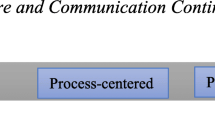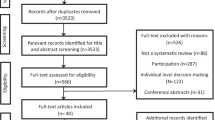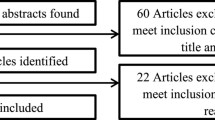Abstract
Background
Some patients with complex healthcare needs become high users of healthcare services. Case management allows these patients and their interprofessional team to work together to evaluate their needs, priorities and available resources. High-user patients must make an informed decision when choosing whether to engage in case management and currently there is no tool to support them.
Objective
The objective of this study was to develop and conduct a pilot alpha testing of a patient decision aid that supports high-user patients with complex needs and the teams who guide those patients in shared decision making when engaging in case management.
Methods
We chose a user-centered design to co-develop a patient decision aid with stakeholders informed by the Ottawa Research Institute and International Patient Decision Aid Standards frameworks. Perceptions and preferences for the patient decision aid’s content and format were assessed with patients and clinicians and were iteratively collected through interviews and focus groups. We developed a prototype and assessed its acceptability by using a think-aloud method and a questionnaire with three patient-partners, six clinicians and seven high-user patients with complex needs.
Results
The three rounds of evaluation to assess the decision aid’s acceptability highlighted comments related to simplicity, readability and visual aspect. A section presenting clinical vignettes including story telling was identified as the most helpful.
Conclusions
We created and evaluated a patient decision aid. Considering the positive comments, we believe that this aid has the potential to help high-user patients with complex care needs make better choices concerning case management.
Plain Language Summary
Some patients are living with physical and mental health problems. They also may have handicaps and unsuitable backgrounds. This may lead them to use health services more often. Case management is a service offered by a team of health professionals. They help patients to decide what is important to them based on their values and preferences. Currently, no tools exist for that service. We built and assessed a tool to support patients in their decisions. With this tool, they think about engaging in case management or continuing with usual care. They can also postpone their decision to a later time. This tool will present data based on scientific studies about case management. It will help patients to clarify their values and preferences to make the best decision for them. This tool was built with a team of researchers, healthcare professionals, managers and patient-partners. It was built according to several guidelines. We met participants and they answered questions that helped us to build our tool. We also ensured the tool was acceptable to them. The most frequent comments were to make it simpler and to use simple vocabulary. The look was also important for the participants. The latter found that the section where patients could write their own story was useful. Patients also found that reading stories about other patients like them was helpful. Our tool will help patients with complex care needs make better choices concerning their health based on their values and scientific data.

adapted from Coulter et al. [30]

Similar content being viewed by others
References
Chan BT, Ovens HJ. Frequent users of emergency departments. Do they also use family physicians' services? Can Fam Physician. 2002;48:1654–60.
Lee KH, Davenport L. Can case management interventions reduce the number of emergency department visits by frequent users? Health Care Manag. 2006;25(2):155–9. https://doi.org/10.1097/00126450-200604000-00008.
Hayes SL, Salzberg CA, McCarthy D, Radley DC, Abrams MK, Shah T, et al. High-need, high-cost patients: who are they and how do they use health care? A population-based comparison of demographics, health care use, and expenditures. Issue Brief (Commonw Fund). 2016;26:1–14.
Byrne M, Murphy AW, Plunkett PK, McGee HM, Murray A, Bury G. Frequent attenders to an emergency department: a study of primary health care use, medical profile, and psychosocial characteristics. Ann Emerg Med. 2003;41(3):309–18. https://doi.org/10.1067/mem.2003.68.
Hansagi H, Olsson M, Sjoberg S, Tomson Y, Goransson S. Frequent use of the hospital emergency department is indicative of high use of other health care services. Ann Emerg Med. 2001;37(6):561–7. https://doi.org/10.1067/mem.2001.111762.
Kumar GS, Klein R. Effectiveness of case management strategies in reducing emergency department visits in frequent user patient populations: a systematic review. J Emerg Med. 2013;44(3):717–29. https://doi.org/10.1016/j.jemermed.2012.08.035.
Wammes JJG, van der Wees PJ, Tanke MAC, Westert GP, Jeurissen PPT. Systematic review of high-cost patients’ characteristics and healthcare utilisation. BMJ Open. 2018;8(9):e023113. https://doi.org/10.1136/bmjopen-2018-023113.
Chiu YM, Vanasse A, Courteau J, Chouinard MC, Dubois MF, Dubuc N, et al. Persistent frequent emergency department users with chronic conditions: a population-based cohort study. PLoS ONE. 2020;15(2):e0229022. https://doi.org/10.1371/journal.pone.0229022.
Billings J, Raven MC. Dispelling an urban legend: frequent emergency department users have substantial burden of disease. Health Affairs (Project Hope). 2013;32(12):2099–108. https://doi.org/10.1377/hlthaff.2012.1276.
Aggarwal, M. et Hutchison, B. (2012). Vers une stratégie des soins primaires pour le Canada. Fondation canadienne pour l'amélioration des services de santé. http://www.cfhi-fcass.ca/Libraries/Reports/Primary-Care-Strategy-FR.sflb.ashx
Government of Canada. Canada's health care system. 2020. https://www.canada.ca/en/health-canada/services/health-care-system/reports-publications/health-care-system/canada.html. Accessed 14 Jul 2020.
Wodchis WP, Austin PC, Henry DA. A 3-year study of high-cost users of health care. Can Med Assoc J. 2016;188(3):182–8. https://doi.org/10.1503/cmaj.150064.
Poitras ME, Maltais ME, Bestard-Denommé L, Stewart M, Fortin M. What are the effective elements in patient-centered and multimorbidity care? A scoping review. BMC Health Serv Res. 2018;18(1):446. https://doi.org/10.1186/s12913-018-3213-8.
Roberts SR, Crigler J, Ramirez C, Sisco D, Early GL. Working with socially and medically complex patients: when care transitions are circular, overlapping, and continual rather than linear and finite. J Healthc Qual. 2015;37(4):245–65. https://doi.org/10.1097/jhq.0000000000000006.
Reeves S, Zwarenstein M, Goldman J, Barr H, Freeth D, Hammick M, et al. Interprofessional education: effects on professional practice and health care outcomes. Cochrane Database Syst Rev. 2008. https://doi.org/10.1002/14651858.CD002213.pub2.
Reeves S, Zwarenstein M, Goldman J, Barr H, Freeth D, Koppel I, et al. The effectiveness of interprofessional education: key findings from a new systematic review. J Interprof Care. 2010;24(3):230–41. https://doi.org/10.3109/13561820903163405.
Zwarenstein M, Goldman J, Reeves S. Interprofessional collaboration: effects of practice-based interventions on professional practice and healthcare outcomes. Cochrane Database Syst Rev. 2009. https://doi.org/10.1002/14651858.CD000072.pub2.
Damery S, Flanagan S, Combes G. Does integrated care reduce hospital activity for patients with chronic diseases? An umbrella review of systematic reviews. BMJ Open. 2016;6(11):e011952. https://doi.org/10.1136/bmjopen-2016-011952.
Hudon C, Chouinard MC, Pluye P, El Sherif R, Bush PL, Rihoux B, et al. Characteristics of case management in primary care associated with positive outcomes for frequent users of health care: a systematic review. Ann Fam Med. 2019;17(5):448–58. https://doi.org/10.1370/afm.2419.
Hudon C, Chouinard MC, Lambert M, Dufour I, Krieg C. Effectiveness of case management interventions for frequent users of healthcare services: a scoping review. BMJ Open. 2016;6(9):e012353. https://doi.org/10.1136/bmjopen-2016-012353.
Elwyn G, Frosch DL, Kobrin S. Implementing shared decision-making: consider all the consequences. Implement Sci. 2016;11:114. https://doi.org/10.1186/s13012-016-0480-9.
Labrecque M, Paunescu C, Plesu I, Stacey D, Legare F. Evaluation of the effect of a patient decision aid about vasectomy on the decision-making process: a randomized trial. Contraception. 2010;82(6):556–62. https://doi.org/10.1016/j.contraception.2010.05.003.
O'Connor AM, Tugwell P, Wells GA, Elmslie T, Jolly E, Hollingworth G, et al. A decision aid for women considering hormone therapy after menopause: decision support framework and evaluation. Patient Educ Counsel. 1998;33(3):267–79. https://doi.org/10.1016/s0738-3991(98)00026-3.
Stacey D, Legare F, Col NF, Bennett CL, Barry MJ, Eden KB, et al. Decision aids for people facing health treatment or screening decisions. Cochrane Database Syst Rev. 2014. https://doi.org/10.1002/14651858.CD001431.pub4.
Towle A, Godolphin W. Framework for teaching and learning informed shared decision making. BMJ (Clin Res Ed). 1999;319(7212):766–71. https://doi.org/10.1136/bmj.319.7212.766.
Shay LA, Lafata JE. Where is the evidence? A systematic review of shared decision making and patient outcomes. Med Decis Mak. 2015;35(1):114–31. https://doi.org/10.1177/0272989x14551638.
The Ottawa Hospital Research Institute. Ottawa Decision Support Framework (ODSF). 2020. https://decisionaid.ohri.ca/odsf.html. Accessed 18 May 2020.
Légaré F, Stacey D, Gagnon S, Dunn S, Pluye P, Frosch D, et al. Validating a conceptual model for an inter-professional approach to shared decision making: a mixed methods study. J Eval Clin Pract. 2011;17(4):554–64. https://doi.org/10.1111/j.1365-2753.2010.01515.x.
Poitras ME, Hudon C, Godbout I, Bujold M, Pluye P, Vaillancourt VT, et al. Decisional needs assessment of patients with complex care needs in primary care. J Eval Clin Pract. 2020;26(2):489–502. https://doi.org/10.1111/jep.13325.
Coulter A, Stilwell D, Kryworuchko J, Mullen PD, Ng CJ, van der Weijden T. A systematic development process for patient decision aids. BMC Med Inform Decis Mak. 2013;13(Suppl. 2):S2. https://doi.org/10.1186/1472-6947-13-s2-s2.
Witteman HO, Dansokho SC, Colquhoun H, Coulter A, Dugas M, Fagerlin A, et al. User-centered design and the development of patient decision aids: protocol for a systematic review. Syst Rev. 2015;4(1):11. https://doi.org/10.1186/2046-4053-4-11.
Luna D, Quispe M, Gonzalez Z, Alemrares A, Risk M, Garcia Aurelio M, et al. User-centered design to develop clinical applications: literature review. Stud Health Technol Inform. 2015;216:967.
Elwyn G, O'Connor A, Stacey D, Volk R, Edwards A, Coulter A, et al. Developing a quality criteria framework for patient decision aids: online international Delphi consensus process. BMJ (Clin Res Ed). 2006;333(7565):417. https://doi.org/10.1136/bmj.38926.629329.AE.
Creswell J. Research design: qualitative, quantitative, and mixed methods approaches. 3rd ed. Thousand Oaks, CA: Sage Publications Inc.; 2009.
Creswell J, Clark V, Creswell JW. Designing and conducting mixed methods research. 2nd ed. Los Angeles, CA: Sage Publications Inc.; 2011.
Hudon C, Chouinard MC, Aubrey-Bassler K, Muhajarine N, Burge F, Bush PL, et al. Case management in primary care for frequent users of health care services: a realist synthesis. Ann Fam Med. 2020;18(3):218–26. https://doi.org/10.1370/afm.2499.
Charters E. The use of think-aloud methods in qualitative research: an introduction to think-aloud methods. Brock Educ. 2003;12(2):68–82.
Morville P. User experience design. Ann Arbor (MI): Semantic Studios. 2020. https://semanticstudios.com/user_experience_design/. Accessed 28 Nov 2019.
O'Connor AM. Validation of a decisional conflict scale. Med Decis Mak. 1995;15(1):25–30. https://doi.org/10.1177/0272989x9501500105.
Legare F, Kearing S, Clay K, Gagnon S, D'Amours D, Rousseau M, et al. Are you SURE? Assessing patient decisional conflict with a 4-item screening test. Can Fam Physician. 2010;56(8):e308–e314314.
Michie S, Fixsen D, Grimshaw JM, Eccles MP. Specifying and reporting complex behaviour change interventions: the need for a scientific method. Implement Sci. 2009;4:40. https://doi.org/10.1186/1748-5908-4-40.
Köpke S, McCleery J. Systematic reviews of case management: too complex to manage? Cochrane Database Syst Rev. 2015. https://doi.org/10.1002/14651858.ED000096.
Noyes J, Booth A, Moore G, Flemming K, Tunçalp Ö, Shakibazadeh E. Synthesising quantitative and qualitative evidence to inform guidelines on complex interventions: clarifying the purposes, designs and outlining some methods. BMJ Global Health. 2019;4(Suppl. 1):e000893. https://doi.org/10.1136/bmjgh-2018-000893.
Hudon C, Chouinard M-C, Brousselle A, Bisson M, Danish A. Evaluating complex interventions in real context: logic analysis of a case management program for frequent users of healthcare services. Eval Prog Plan. 2020;79:101753. https://doi.org/10.1016/j.evalprogplan.2019.101753.
Reilly S, Miranda-Castillo C, Malouf R, Hoe J, Toot S, Challis D, et al. Case management approaches to home support for people with dementia. Cochrane Database Syst Rev. 2015. https://doi.org/10.1002/14651858.CD008345.pub2.
Michie S. Designing and implementing behaviour change interventions to improve population health. J Health Serv Res Policy. 2008;13(Suppl. 3):64–9. https://doi.org/10.1258/jhsrp.2008.008014.
Michie S, Johnston M, Francis J, Hardeman W, Eccles M. From theory to intervention: mapping theoretically derived behavioural determinants to behaviour change techniques. Appl Psychol. 2008;57(4):660–80. https://doi.org/10.1111/j.1464-0597.2008.00341.x.
Tomko C, Davis KM, Luta G, Krist AH, Woolf SH, Taylor KL. A comparison of web-based versus print-based decision AIDS for prostate cancer screening: participants' evaluation and utilization. J Gen Intern Med. 2015;30(1):33–42. https://doi.org/10.1007/s11606-014-2994-7.
Politi MC, Adsul P, Kuzemchak MD, Zeuner R, Frosch DL. Clinicians' perceptions of digital vs paper-based decision support interventions. J Eval Clin Pract. 2015;21(2):175–9. https://doi.org/10.1111/jep.12269.
Baptista S, Teles Sampaio E, Heleno B, Azevedo LF, Martins C. Web-based versus usual care and other formats of decision aids to support prostate cancer screening decisions: systematic review and meta-analysis. J Med Internet Res. 2018;20(6):e228. https://doi.org/10.2196/jmir.9070.
Ankolekar A, Vanneste BGL, Bloemen-van Gurp E, van Roermund JG, van Limbergen EJ, van de Beek K, et al. Development and validation of a patient decision aid for prostate. Cancer Ther BMC Med Inform Decis Mak. 2019;19(1):130. https://doi.org/10.1186/s12911-019-0862-4.
Lee CN, Dominik R, Levin CA, Barry MJ, Cosenza C, O'Connor AM, et al. Development of instruments to measure the quality of breast cancer treatment decisions. Health Expect. 2010;13(3):258–72. https://doi.org/10.1111/j.1369-7625.2010.00600.x.
Acknowledgements
The authors thank all the patients that contributed to this research, the Quebec SPOR SUPPORT Unit. France Légaré holds the Canada Research Chair in Shared Decision Making and Knowledge Translation.
Author information
Authors and Affiliations
Corresponding author
Ethics declarations
Funding
This research project was funded by the Quebec-SPOR SUPPORT Unit, a methodological platform of the Canadian Institutes of Health Research, Strategy for Patient-Oriented Research.
Conflicts of Interest/Competing Interests
Marie-Eve Poitra, France Légaré, Vanessa T. Vaillancourt, Isabelle Godbout, Annie Poirier, Karina Prévost, Claude Spence, Maud-Christine Chouinard, Hervé Tchala Vignon Zomahoun, Lobna Khadhraoui, José Massougbodji, Mathieu Bujold, Pierre Pluye and Catherine Hudon have no conflicts of interest that are directly relevant to the content of this article.
Ethics Approval
Ethics approval was obtained from the Ethics Committee of the Centre Intégré Universitaire de Santé et de Services Sociaux du Saguenay-Lac-Saint-Jean.
Availability of Data and Material
The datasets generated and/or analysed during the current study are available from the corresponding author on reasonable request.
Consent to participate
All participants gave their informed consent to participate in the study.
Consent to publish
All authors gave their consent to publish and approved the final version of the article.
Code Availability
Not applicable.
Authors’ Contributions
MEP is the principal investigator of the study. She conceived the idea for the paper and led the writing. VTV and FL were major contributors to the drafting of the paper. CH is the principal author of the systematic review used to create the decision aid. FL, IG, MB, CP, AP, MCC, BD, PP, KP and CH were involved in the design, data collection and conduct of the study. HZTV, JM and LK were involved in the data extraction and analysis.
Additional information
Digital Features
To view digital features for this article go to https://doi.org/10.6084/m9.figshare.12911456.
Electronic supplementary material
Below is the link to the electronic supplementary material.
Rights and permissions
About this article
Cite this article
Poitras, ME., Légaré, F., Tremblay Vaillancourt, V. et al. High Users of Healthcare Services: Development and Alpha Testing of a Patient Decision Aid for Case Management. Patient 13, 757–766 (2020). https://doi.org/10.1007/s40271-020-00465-0
Accepted:
Published:
Issue Date:
DOI: https://doi.org/10.1007/s40271-020-00465-0




